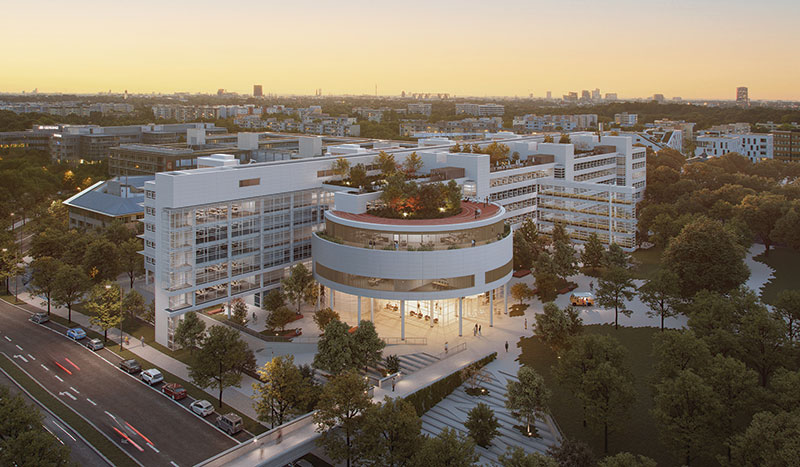
Hines will retrofit this former Munich office complex, renamed Aer, with green energy upgrades to achieve carbon neutrality and a designation from the German Sustainability Council. The former office buildings will be transformed into a flagship mixed-use development with a residential component. (Courtesy of Hines)
Turning a 50-year-old, 20-story office tower into a Leadership in Energy and Environmental Design (LEED) Platinum–certified building clearly required a deep retrofit. In 2017, when LaSalle Investment Management acquired 275 Slater Street in Ottawa, its underwriting included those next-level improvements. Whether a simple energy efficiency upgrade or a larger overhaul is needed, retrofitting is becoming an important component of the real estate industry.
“In Ottawa, we were making a classic investment thesis for a core long-term hold, so we were looking at a five- to 10-year plan to phase in energy-efficient retrofits alongside other capital improvements,” says Elena Alschuler, Americas head of sustainability for LaSalle Investment Management.
LaSalle reduced energy use by about 20 percent in the building, Alschuler says, with incremental steps such as replacing the lighting, improving the building facade, and installing variable-speed drives for the heating, ventilation, and air-conditioning (HVAC) system. LaSalle also installed low-flow water fixtures to cut water use.
While property owners embrace retrofits to improve operating efficiency, attract tenants, and meet their own sustainability goals, other forces are also driving interest in retrofits.
“Institutional investors have ESG [environmental, social, and governance] goals, so property owners may be required to meet energy targets to receive funding,” says Chris Gray, chief technology officer of RENU Communities, a subsidiary of Taurus Investment Holdings. “Approximately half of all multifamily buildings in the U.S. were built before 1990, which means they’re more than 30 years old and need upgrades.”
In addition, national, state, and local governments are introducing codes that will force property owners to meet energy efficiency goals. Local Law 97 in New York City, for example, requires large buildings to reduce their greenhouse gas emissions by 40 percent in 2030 and by 80 percent in 2050.
“大约40辖区已经碳emission reductions in place, and we’re anticipating that number to grow,” says Alschuler. “There’s also more tenant demand and investor demand for sustainable improvements.”
It’s easy to see why. Buildings account for 40 percent of carbon emissions globally. Eighty percent of buildings that will exist in 2050 are already standing in cities around the world. To achieve net zero carbon emissions by 2050, a goal embraced by numerous countries including the United States, it will be necessary to retrofit existing buildings.
Acquisition Analysis and Portfolio Reviews
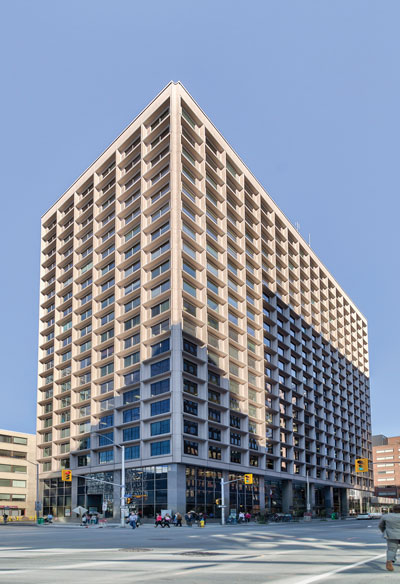
Located in downtown Ottawa, 275 Slater Street is a 55-year-old property upgraded to achieve LEED Platinum and Energy Star certifications. The property’s systems, including lighting, HVAC, a heat curtain, and water and elevator controls, were upgraded, resulting in a more energy-efficient building. (Courtesy of Lasalle)
At RENU and throughout Taurus Investment’s portfolio, every property, whether it is being considered as an acquisition or for a retrofit, has an energy plan, Gray says.
“We start with a high-level analysis, then we bid it out, do a deeper dive, and generate computerized models to understand preferred solutions in the context of our investment threshold,” he says.
Sustainability improvements often start with a review of consumption patterns, followed by an individualized plan for retrofits. “At Hines, our mission is to reduce energy use first before looking at adding renewable energy sources,” says Michael Izzo, vice president for carbon strategy at Hines. “The opportunity to reduce energy waste is quite large across all asset classes.”
Like many companies, LBA Realty starts by making behavioral and operational efficiency upgrades, such as looking at how a building is started up and shut down every day, says Michelle German, vice president of ESG for LBA Realty.
“The second step is to look at the mechanical and building systems to see what we can retrofit, whether there is technology available to improve efficiency, and what we can select to reduce consumption further,” German says. “We only look at solar after that because if you install solar first, you could end up generating more than you need.”
Logistical Challenges of Retrofits
The challenges of a retrofit, and often the cost/benefit analysis, depend on the property, its age, and its architecture.
“Probably the most challenging technically is to retrofit a big tower with a central plant, especially if it has gas heat,” says Alschuler. “You can do that with multiyear phasing, but you need every part to be compatible.”
Perhaps the easiest retrofit, she says, is a garden-style apartment complex in which each unit has an individual HVAC system.
“Market factors and asset factors need to come together, so we need to know where a building is in its leasing structure, the cycle of its systems such as the HVAC, and the cost of any proposed retrofit,” Alschuler says.
Other logistical factors come into play with different property types.
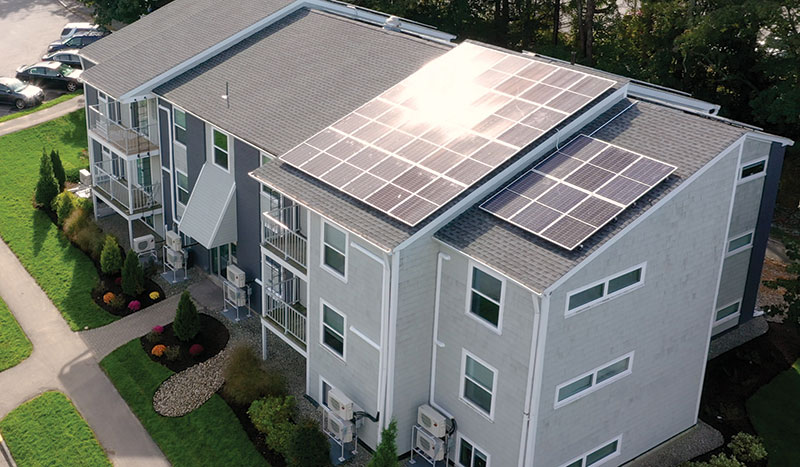
RENU Communities installed cold-climate heat pumps for all 404 units of its South Winds multifamily property in Falls River, Massachusetts. It uses the Home Energy Rating System Index to evaluate energy use in its multifamily buildings. South Winds saw 80 percent energy savings after retrofits. (Courtesy RENU Communities, a subsidiary of Taurus Investment Holdings LLC)
Multifamily
For Marhnos, a Mexico City–based developer, class B-plus, B, and C apartments in high-growth areas in Texas provide an opportunity for value add with retrofits.
“Our core business is to target garden-style apartments built in the 1960s, 1970s, and 1980s, analyze their HVAC and water systems, and make improvements on a case-by-case basis,” says Nick Gruy, director of acquisitions and development for Sentinel Capital LLC, a partner with Marhnos in Texas. “The 1960s-vintage buildinMarhgs can be a bigger concern because it’s not easy to replace an old chiller system. Sometimes you need to replace the electric transformers and electric panels in each unit or we find asbestos in the walls. But even if it’s expensive and time-consuming, the end result can be great for the community.”
Gruy sees retrofits as a triple win—good for people, the planet, and profits.
In some cases, Marhnos will install low-flow water fixtures, replace leaky windows with double-pane windows, and use passive landscaping techniques to reduce heat in the units without eliminating light, Gruy says.
“If we can reduce gas costs by 75 percent, lower water consumption, and cut everyone’s bills, that can be a better scenario sometimes than replacing the entire HVAC system,” he says.
Essentially, the goal is to create better communities with happier tenants, improve net operating income (NOI), and increase value, says Blanca Rodriguez, director of capital and finance for Marhnos.
“Our goal with every property is to make it profitable, beneficial in the long term for the tenants and our investors, and position the asset better in every way for when we want to exit the asset,” Rodriguez says.
Garden apartments offer the option of phasing in retrofits. For example, at a LaSalle property in Denver, about 10 percent of the units are being retrofitted each year.
“In a high-rise. You need to plan with the contractors to replace windows one day, doors on another, and then do the insulation and mechanical upgrades while the old systems are still in place,” says Gray. “It’s like a big puzzle to work this out with the least possible disruption to tenants.”
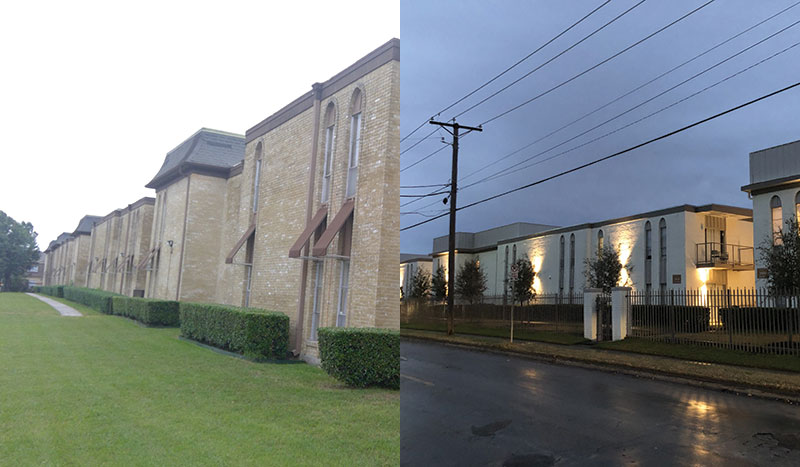
Before and after a rehab project lead by developer Marhnos. Eclipse at Oak Lawn is located in the heart of Dallas, where residents can expect a vibrant, active community. It has the perfect location for people who want to live in an urban-feel neighborhood with a fresh, high-spirited environment and the perk of a short commute to downtown. (Photos Courtesy Marhnos)
Office
High-rise offices present challenges similar to those of high-rise residential buildings, says Gray, except that work can be done on nights and weekends when the space is unoccupied. In addition, it is possible to do more work in phases and move tenants within the building more easily.
Retrofitting an older office can be especially challenging when it uses steam heat and natural gas. For example, the 17-story Hines building at 345 Hudson Street in New York City, a 1 million-square-foot (93,000 sq m) tower built in the 1930s, needed to be electrified. The building has both centralized and decentralized systems. Hines was able to replace the centralized system at the top of the building, then replace outdated individualized systems as tenant spaces turn over.
“Essentially, we’re using the new heat pumps to move heat around the building as needed, which is based on a system that’s been used in Europe for decades,” Izzo says. “Basically, we move heat from the core of the building, where it’s always stays cool in winter, to the exterior where heat is needed, and then do the opposite when air conditioning is needed. This is significant because we have all the heat we need and have immediate results.”
As soon as the new system was implemented, the building had a 40 percent reduction in carbon emissions, an 88 percent reduction in heating costs, a 98 percent reduction in gas consumption, a 44 per
cent reduction in energy costs, and a 28 percent reduction in electricity use.
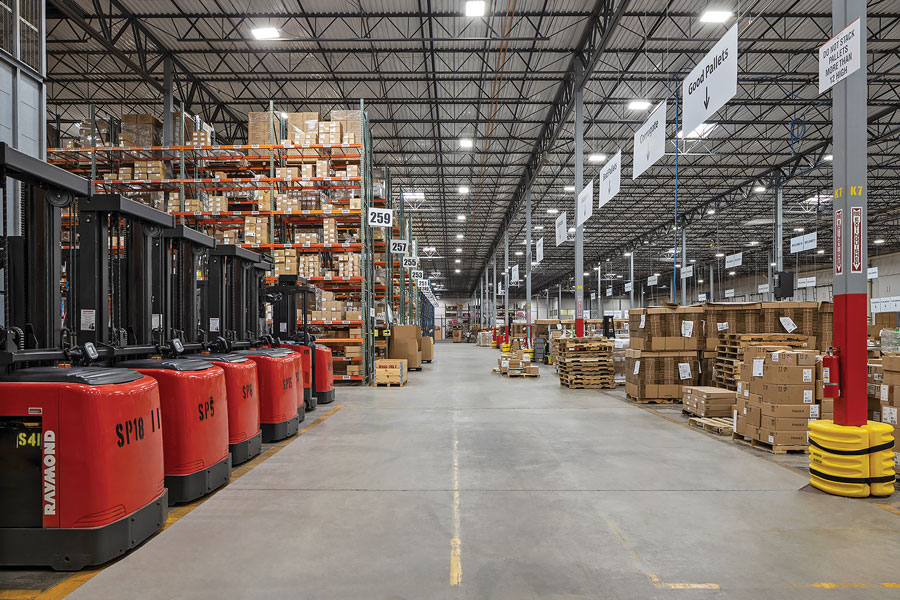
LBA Realty’s portfolio is 90 percent industrial properties, which typically have triple-net leases in which the tenant controls and pays utilities. To achieve higher performance, LBA installs LED lighting as well as occupancy sensors and sometimes introduces HVAC upgrades and tenant education on sustainability. (Courtesy of LBA Logistics)
Industrial
About 90 percent of LBA’s portfolio is industrial properties, which typically have triple-net leases, German says.
“With industrial properties, the tenant controls and pays the utilities, so we don’t have a lot of insight into consumption,” German says. “For our industrial properties, installing LED lighting is a top priority. We also add things like occupancy sensors and sometimes HVAC upgrades.”
German says that while many office tenants have ESG goals of their own, that is less common with industrial tenants, so LBA provides them with education on sustainability.
Making the Money Work
The starting point for many retrofits is a simple calculation of how much money can be saved on utility bills for each dollar spent on improving energy efficiency, Gray says.
“We also project the potential increase in value of a retrofitted property,” he says. “On the flip side, it’s important to project what would happen if we don’t do anything. A building with a high carbon footprint could be devalued because buyers won’t be interested in purchasing a property that needs extensive retrofitting unless they can get it at a discount.”
For properties intended to stay in a portfolio, the calculation includes the potential to attract and retain tenants as well as increase the rent, Gray says.
“我们总是看到格力之间的正相关关系n certifications, property performance, and tenant satisfaction,” says Alschuler. “The studies we’ve seen show that rents are anywhere from 3 to 33 percent higher for office space with green improvements, and from 4 to 40 percent higher for multifamily buildings. Often, you only need a rent increase of 1 or 2 percent to justify the costs.”
The business case also depends on the owner’s plans for the property. For example, LBA typically follows a short-term hold plan of five to seven years. “That doesn’t give us a lot of runway for NOI, so we tend to focus on things like window tinting rather than replacing all the windows,” German says.
Financial Support for Retrofits
A variety of funding options are available for retrofits, including green loan programs from Fannie Mae and Freddie Mac, the Commercial Property-Assessed Clean Energy (C-PACE) program from the U.S. Department of Energy, on-bill financing through utility companies, and financing through energy service companies and green banks. Also, a variety of incentives, grants, and rebates are available from state, local, and federal governments. Inflation Reduction Act (IRA) incentives can be combined with state and local incentives and rebates for elements such as cold-climate air-source heat pumps, heat-pump water heaters, geothermal heat pumps, efficient heating and cooling equipment, and electric panel or circuit upgrades for new electrical equipment.
“We always look for incentives and typically plan our improvements to catch an incentive before it expires or wait until one starts,” says Alschuler.
In New York, the New York State Energy Research and Development Authority (NYSERDA) introduced the Empire Building Challenge, which includes $50 million in grants to support energy efficiency retrofits.
“One of the biggest challenges to decarbonization is tall existing buildings in cold-climate locations like New York City,” says Michael Reed, assistant director of advanced efficiency solutions at NYSERDA. “The Empire Building Challenge’s goal is to support companies that demonstrate energy efficiency projects while driving the market and competitors to make similar retrofits. We also want to foster partnerships between solution providers and property owners.”
Among the simplest steps for property owners is to adapt smart controls so energy use more closely correlates with occupancy, Reed says. “We want to avoid heating and cooling places that are unoccupied, which was vividly demonstrated during the early months of the pandemic when occupancy was near zero but energy consumption declined just 30 percent,” Reed says.
To qualify for a grant, each company needed to provide a road map with specific retrofit projects to achieve the goal of phasing out fossil fuels while maintaining comfort and sustainability, Reed says. “The idea is that once the cost/benefit of retrofits is proven, companies won’t need subsidies,” Reed says. “We need the market to prove that these retrofits can be replicated at scale.”
Monitoring Performance Metrics
Many systems are available to analyze building performance. For example, RENU uses
the Home Energy Rating System (HERS) Index to evaluate energy use in its multi-family buildings.
“在我们南公寓在秋天风河,质量achusetts, we had a HERS rating of 170 before our retrofits and one in the 30s afterwards,” says Gray. “That’s an 80 percent energy savings.”
Besides tracking energy consumption with sensors and through bills, developers rely on Leadership in Energy and Environmental Design (LEED), the Building Research Establishment Environmental Assessment Method (BREEAM, the U.K. equivalent of LEED), and Europe’s Carbon Risk Real Estate Monitor (CRREM) for benchmarking progress.
LBA partners with Yardi Pulse for real-time monitoring of the HVAC system and fault detection in all its office buildings, says German.
“Yardi Pulse uses AI [artificial intelligence] overlays to learn how the building operates and make minor adjustments that keep tenants comfortable but reduce consumption and save money,” German says. In the United States, retrofitting is still in its infancy, but it will pick up over time, Izzo says.
“As companies and cities miss their targets, policies are likely to come down harder and [companies] will risk fines and face compliance consequences,” Izzo says. “Plus, people are conscious of the impact of buildings on the environment and want better choices, so the market is responding.”
MICHELE LERNER is a freelance writer, editor, and author covering real estate, personal finance, and business topics for such publications as theWashington Post,USA Today, and others.

